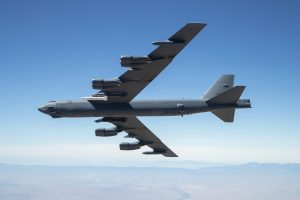Hypersonic capabilities are becoming a high-priority security imperative for states like China, Russia, and the United States. While China and Russia are now reportedly moving ahead in terms of deploying hypersonic capabilities, the U.S. is facing several difficulties in the same domain.
The U.S. Air Force recently conducted the final test flights of its hypersonic missile program, the AGM-183A Air-launched Rapid Response Weapon (ARRW). The ARRW program was launched in April 2018 and originally planned to achieve initial operational deployment in 2022. However, in November 2023, after conducting two test flights in August and October 2023, the ARRW hypersonic program was officially cancelled.
The Senate Armed Services Committee budget document 2023 clearly stated, “in light of testing failures and statements from Air Force leadership in support of the competitor program, the committee is concerned that continued testing at the scale originally planned in the budget request seems unlikely to deliver persuasive results.”
It is clear that the U.S. hypersonic program is lagging behind those of its primary adversaries due to multiple factors, and the cancellation of the ARRW hypersonic program sheds light on this.
System Description of the ARRW Hypersonic Program
The ARRW was planned as a conventional, air-launched boost-glide hypersonic weapon. The ARRW used a solid-rocket motor booster, similar to a modified version of the MGM-140 Army Tactical Missile System (ATACMS), a ground-launched short-range ballistic missile. The ARRW essentially took help from the Tactical Boost Glide (TAG) program, which is a joint effort of the U.S. Air Force and the Defense Advanced Research Projects Agency.
In terms of its structure, the ARRW consists of a glider protective shroud and a glider vehicle with a kinetic-energy projectile warhead. While during the test phase, the ARRW was launched from a B-52H aircraft, the Air Force planned to deploy the weapon on other aircraft, such as the B-1 bomber and F-15 fighter.
The U.S. Air Force initially planned to test the ARRW at engagement and mission levels by assessing ARRW capacities against surface-to-air missile systems and anti-aircraft artillery batteries. The program, however, suffered a series of failures since its inception. In 2021, on three occasions, ARRW tests reportedly failed. The ARRW program did find success in two booster test flights in 2022. But in August and October 2023, the U.S. Air Force conducted the final test flights of this hypersonic missile program. Afterward, the Air Force released a note stating that it had gained “valuable new insights into the capabilities of this new, cutting-edge technology” and collected “valuable, unique data,” according to a release. The information will “further a range of programs such as ARRW and the Hypersonic Attack Cruise Missile.”
Shifting Goalposts
While the ARRW program is now officially cancelled, the U.S. Air Force currently plans to advance with its Hypersonic Attack Cruise Missile (HACM) and the Hypersonic Air-Launched Offensive Anti-Surface Warfare (HALO) Weapon System.
The Air Force plans to field the HACM weapon system as early as 2027. If deployed as scheduled, it would be the first air-launched hypersonic cruise missile; currently, neither Russia nor China have air-launched hypersonic cruise missile capabilities. However, the development of the HACM shows the apparent shortcomings of the U.S. hypersonic defense program. The HACM has a range of less than 1,000 kilometers, because it uses a supersonic combustion ramjet engine; this essentially curtails the U.S. Air Force’s future plan to have a stand-off land-attack capability.
In comparison, China in October 2019 already delivered the DF-ZF (previously called WU-14), a boost-glide vehicle (BVG) carried on a DF-17 booster with a range of 1,200 km, attaining a speed of Mach 5-10. On the other hand, Russia, in addition to its long-range Avangard BGV, has reportedly tested a ship-based HCM, the Tsirkon (Zircon), with a range of 400-1,000 km.
There are at least two important reasons why the U.S. hypersonic program faces failure and lags behind its adversaries, such as China and Russia. The first reason is the confusion about what sort of hypersonic system needs priority. Currently, the Pentagon is funding around half a dozen different hypersonic weapon programs under two broad hypersonic technologies: cruise missiles that use an air-breathing jet engine known as a scramjet and glide vehicles that are launched from the air and then glide to their targets at high speeds. However, the problem is deciding which technology needs more attention and resources.
When asked about the plan of action regarding the hypersonic weapon system, William Roper, the former head of Air Force acquisition, stated, “There wasn’t a strategy during my time at the Pentagon… from what I can see from the outside, there doesn’t appear to be one now.”
The second reason is the apparent lack of infrastructure capabilities required for testing. Wind tunnel infrastructure is the most critical element when testing weapons capabilities, especially in the context of hypersonic weapons. Beyond thermal management testing, hypersonic weapons also need to be tested on the lines of aerodynamic pressures, and this is where wind tunnel infrastructure becomes critical. Currently, the United States has around 26 wind tunnels assisting in hypersonic testing, but these are decades-old installations. The Government Accountability Office report published in 2021 pointed out that “of the 26 DOD [Department of Defense], DOE [Department of Energy], NASA [National Aeronautics and Space Administration], and private U.S. wind tunnel facilities capable of supporting hypersonic research, 14 were constructed prior to 1970.”
Hypersonic technologies are not new, and the research goes back to the early heydays of the Cold War when the United States managed to fly the X-15, a manned hypersonic test aircraft. However, the U.S. found it difficult to keep up the pace on hypersonic technologies over the years. In the meantime, Russia and especially China took advantage of U.S. research available in the public domain about hypersonic technologies and accelerated their efforts to develop and deploy hypersonic weapons. Until and unless the United States overcomes challenges associated with the strategy, planning, and infrastructure, it will be difficult for it to counter Russia’s and China’s growing clout in the hypersonic arena.

































